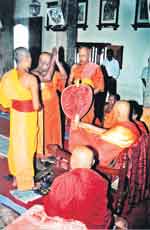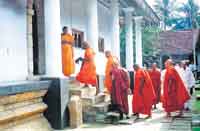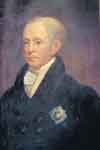Higher ordination is restored
At a time when Buddhism had reached a low ebb during the Kandyan period, the monks did not have an opportunity to obtain upasampada or higher ordination due to lack of monks who were well versed in the Dhamma. This prevented the novice monks from becoming fully fledged members of the Maha Sangha. Due to the initiative of that great monk, Vilivita Sri Saranankara Thera (who later became the first Sangharaja), King Kirti Sri Rajasinghe arranged to get monks from Siam (present Thailand) and restore higher ordination in Sri Lanka. On July 19, 1753 - 253 years ago - Upali Maha Thera from Siam conducted the upasampada ceremony at the Malwatu Maha Vihara in Kandy.
The samanera or novice monk has to lead a pious life and study the Buddhist scriptures and reach a qualifying standard to receive higher ordination. Today upasampada ceremonies are held annually in major temples with the participation of the Maha Nayaka Thera of the particular nikaaya (sect) and other senior monks who question novice monks and satisfy themselves that they are qualified to receive higher ordination. Apart from the knowledge of the Dhamma they are also questioned on some basic prerequisites. Each monk is asked whether he is over 20 years of age, whether he is in debt or in the king's service (whether he is employed in today's context), whether he has got permission from the parents to become a monk and whether he is suffering from any serious illness. He is advised to answer truthfully without feeling shy. He also has to possess a robe and an alms bowl. Once the senior monks are satisfied that he is suitable to receive higher ordination, he has to ask them that he be granted higher ordination. After granting upasampada, he is advised on how he should conduct himself thereafter.
Second British Governor
The second British Governor, Sir Thomas Maitland arrived in Ceylon on July 17, 1805 to succeed Frederick North (1798-1802), who was referred to as "a young man in a hurry.” It fell on Maitland to put the house in order since North had made many blunders and the administration had weakened. In order to study the situation in the country, Maitland spent six months travelling round and got to know the problems. Thereafter he set about the task of solving those problems. He reorganized the army by ensuring that there is no insubordination. Then he cleaned the civil service where there was corruption. He also brought back the system of service tenure (rajakariya) whereby the people had to perform certain amount of work every year. North had abolished this system which was in operation from the time of the Sinhalese kings. Maitland took a bold step in bringing it back. He also reformed the minor judiciary. Tactfully, Maitland avoided clashing with the King of Kandy and no attempt was made during his period to wage war or capture the Kandyan kingdom. Maitland was the first occupant of the present President's House which was originally the residence of John Gerrard van Angelbeek, the Dutch governor. He maintained a country residence in Mount Lavinia at the present site of the Mount Lavinia Hotel. Having administered the country for seven years Maitland left in 1811 and was succeeded by Sir Robert Brownrigg, the conqueror of Kandy. |
||||||||||
Copyright © 2006 Wijeya Newspapers
Ltd. All rights reserved. |


